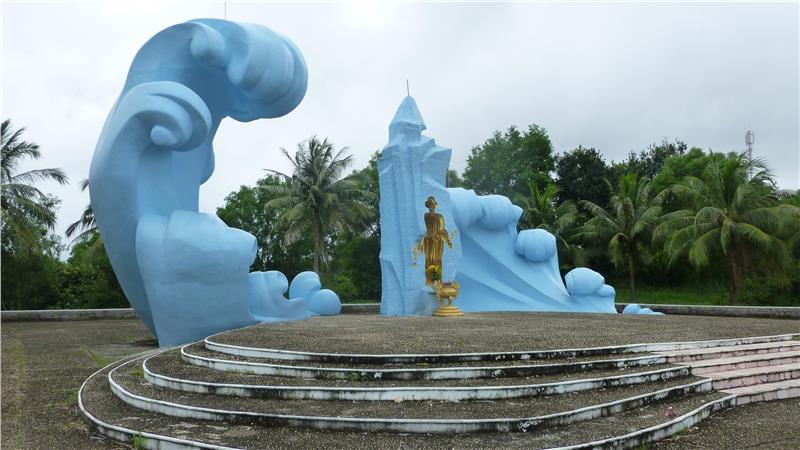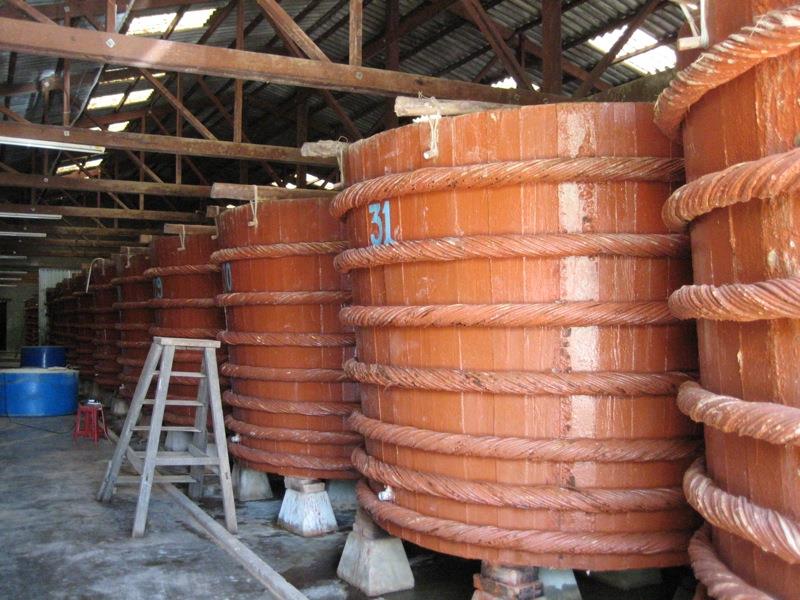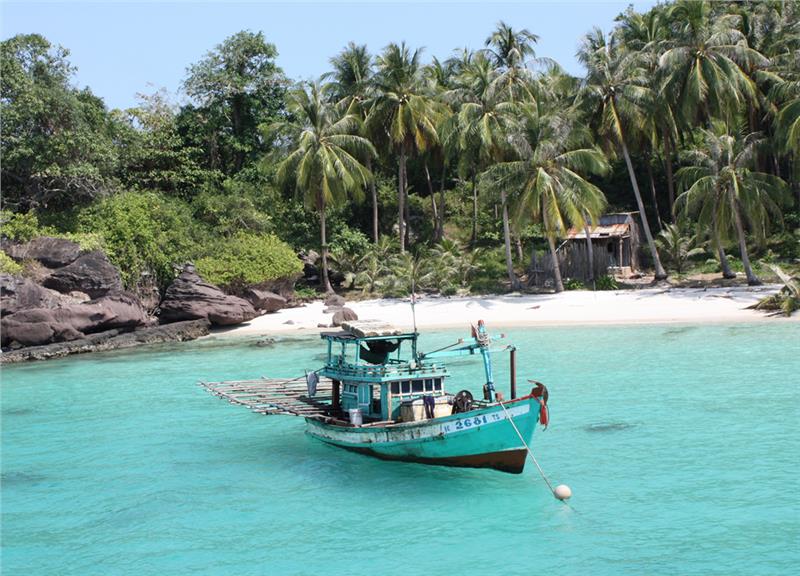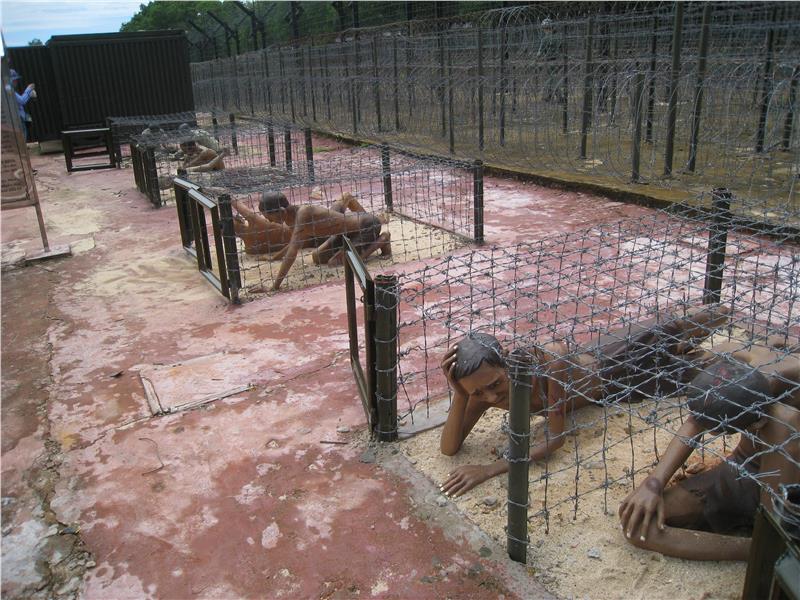Phu Quoc, the largest island in Vietnam, is the largest island of the 22-island archipelago here, located in Gulf of Thailand. Phu Quoc Island and other islands founded Phu Quoc island district directly under Kien Giang province. Accordingly, Duong Dong town which is situated in the northwest of the island is the metropolis of the district. In 2006, coastal Biosphere Reserve and Kien Giang island waters, including Phu Quoc district are recognized as World Biosphere Reserve by UNESCO.
Geographic location: Phu Quoc Island is situated in Gulf of Thailand, to the southwest of Vietnam. The district stretches from 9°53′ to 10°28′ north latitude and 103°49′ to 104°05′east longitude.
Terrain: Phu Quoc waters includes 22 large and small islands, of which Phu Quoc Island is the the largest one with the area of 567 km² (56.700 ha), and the length of 49 km. Natural terrain slopingly runs from north to south with 99 hills. However, clusters of small islands in An Thoi port are be separated with the southern tip of Phu Quoc island by a strait with the depth of more than 60m.
Climate: the moderate weather in Phu Quoc brings the tropical monsoon climate. Phu Quoc Island has two distinct seasons. The dry season is influenced by the Northeast monsoon. The high temperature is 350C in April and May. On rainy season, Phu Quoc Island is the gateway to welcome west - southwest monsoon with the high humidity from 85 to 90%.

Phu Quoc was named by first Chinese people who went to settle their life. The name means “a prosperous land”. In 1671, Mac Cuu - a native of Leizhou (Guangdong - China), landed in a wasteland which is located in the Gulf of Thailand. Mac Cuu and his family, together with his soldiers stayed here, founded villages from Vung Thom, Trung Ke, Can Vot, Rach Gia to Ca Mau as today. Mac Cuu also set up seven large casinos along the coast, namely Man Kham (Peam), Long Ky (Ream), Can Bot (Kampot), Huong Uc (Kompong Som), Sai Mat (Cheal Meas), Linh Quynh (Rach Gia) and Phu Quoc (Koh Tral). Not long afterwards, the area became a prosperous territory with a new name of Can Khau Quoc. Koh Tral Island is also renamed into Phu Quoc (a prosperous land). Over many ups and downs in its history, it can be said Mac family directly expanded and held the exploitation of Phu Quoc, Ha Tien, and an immense area including mostly provinces of Mekong River Delta Vietnam today.
Phu Quoc with the total area of 589,23 km² comprises two towns: Duong Dong, An Thoi, and eight communes: Duong To, Cua Can, Ganh Dau, Cua Duong, Bai Thom, Hon Thom, Ham Ninh, and Tho Chau.
According to statistics of Kien Giang province in 2003, population in Phu Quoc was about 79,800 persons, with the average population density of 135 persons / km². Main residential areas includes Duong Dong town, An Thoi town, Ham Ninh Fishing Village, Cua Can fishing village, and Hon Thom island commune.

Referring to Phu Quoc, it will be a deficiency if traditional occupations are not mentioned, namely fish sauce production and pepper cultivation. Phu Quoc fish sauce and Phu Quoc pepper have long been famous worldwide, contributing a great number of production revenue in the island. Apart from 2 above fields, the main economic activity of residents in Phu Quoc is the exploitation of marine resources. Recently, thanks to the rapid development of tourist activity on the island, some parts of residents here have moved to provide travel services such as restaurants and hotels. In addition, as a large island, other resources such as marine resources, land resources, water resources...here have a great potential to exploit in order to develop economy in Phu Quoc. In 2011, the growth rate in the island reached 26.46%. In which, agriculture - forestry - fishery increased 12.23%, aquaculture was up to 56.74%, industry added to 23.4%, basic construction mounted up 23.53%, services and other sectors built up 25%.
Education: Education sector is well maintained, the unit continues to perform as scheduled teaching time as well as programs. There are currently 26/27 schools getting standard of green - clean - beautiful schools. Continuing education centers continuously enrolled classes on certificates of A, B information technology and foreign languages; simultaneously, promoted the enrollment of primary classes such as tourism, consumer electronics...according to National Target Program 2014.
Health: medical examination and treatment for people has been efficiently held. Health centers, health care organizations actively participate in training and working to ensure health for people of whole district.
Religion: Phu Quoc is considered as the home to Caodaism. There still exists a Caodaism Temple in Duong Dong town. Besides, there is only one Catholic Church in An Thoi town.

Phu Quoc owns many beautiful beaches stretching from north to south. There are also 99 hills and ranges of primary forest with diverse flora and fauna. 12 islands with abundant shapes belonging to An Thoi archipelago to the south of the island, or Nail (Mong Tay) Islet, Doi Moi Islet to the north...are ideal rendezvous for activities of yachting, fishing, snorkeling, diving, and exploring uninhabited island...
Phu Quoc tourism also combines many types of exploration on cultural historical relics, revolutionary history, customs and habits of island residents, fishing villages, traditional handicraft villages, natural ecosystems. Especially, visiting Coconut Tree Prison, historical relics - a beautiful symbol on revolutionary heroism will be unforgettable experiences.
In addition, beautiful scenery, namely Duong Dong, Duong To, An Thoi, Ham Ninh, Vong Beach, Khem Beach, Sao Beach, Ganh Dau, Cua Can, Tranh Spring, Da Ban Stream...always leave deeply impression on tourists once setting foot in the wonderful island. If you would like to visit Phu Quoc, there are daily flights from Hanoi to Phu Quoc and Ho Chi Minh City to Phu Quoc.

Phu Quoc has invested and upgraded tourism products associated with bathing, relaxing, camping, shopping, sightseeing of historical cultural relics, ecotourism, sports, entertainment, conferences, seminars, visiting traditional villages, farms, aquaculture, and natural ecological research...The island gradually establishes tourist routes on the basis of specific tourism products aiming to serve tourists with the best quality.
It’s is said that Phu Quoc festivals have origin from the Southern of Chinese who first immigrated to this island in 17th century. The local festival days based on the lunar calendar and most of them relating to fishermen life and religious belief. There are some unique traditional festivals in Phu Quoc actually lure both domestic and foreign tourists with their excellent performances and activities:
- Gia Long King's Temple day (Jan. 15)
- Bon Canh Temple day (May 16)
- Temple consecration and offering (July 15)
- Phu Quoc jail martyr Vietnamese monument's day (July 27)
- Sung Hung Ancient Pagoda consecration (July 30)
- Nguyen Trung Truc monument's day (August 27)
- Dinh Cau Temple festival (lunar Oct 15 and 16)
- Thuy Long Thanh Mau Temple festival (lunar Nov., 20).
